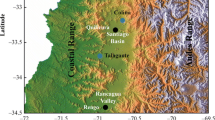Abstract
With the 3D chemical transport model OSLO CTM2, the valley of total column ozone over the Tibetan Plateau in summer is reproduced. The results show that when the ozone valley occurs and develops, the transport process plays the main part in the ozone reduction, but the chemical process partly compensates for the transport process. In the dynamic transport process of ozone, the horizontal transport process plays the main part in the ozone reduction in May, but brings about the ozone increase in June and July. The vertical advective process gradually takes the main role in the ozone reduction in June and July. The effect of convective activities rises gradually so that this effect cannot be overlooked in July, as its magnitude is comparable to that of the net changes. The effect of the gaseous chemical process brings about ozone increases which are more than the net changes sometimes, so the chemical effect is also important.
Similar content being viewed by others
References
Bertsen, T., and I. S. A. Isaksen, 1997: A global 3D chemical transport model for the troposphere, 1: Model description and CO and ozone results. J. Geophys. Res., 102, 21239–21280.
Bian J. C., Li W. L., and Zhou X. J., 1997: Analysis of the seasonal variation feature of the winds structure over Tibetan Plateau and its surroundings. Ozone Changes Over China and Its Influences on Climate and Environment, Zhou X. J., Ed., China Meteorological Press, Beijing, 257–273.
Flatøy, F., and Ø. Hov, 1996: Three-dimensional model studies of the effect of NO× emission from aircraft in the upper troposphere over Europe and North Atlantic. J. Geophys. Res., 101, 1401–1422.
Fu C., Li W. L., and Zhou X. J., 1997: Numerical simulation of the formation of ozone valley over Tibetan Plateau in summer, its surroundings. Ozone Changes Over China and Its Influences on Climate and Environment, Zhou X. J., Ed., China Meteorological Press, Beijing, 274–285.
Hesstvedt, E., Ø. Hov, and I. S. A. Isaksen, 1978: Quasi steady-state approximation in air pollution modelling: Comparison of two numerical schemes for oxidant prediction. Int. Journal of Chem. Kinetics, X, 971–994.
Holtslag, A. A. M., E. I. F. DrBruijn, and H.-L. Pan, 1990: A high resolution air mass transformation model for short-range weather forecasting. Mon. Wea. Rev., 118, 1561–1575.
Jonson, J. E., J. K. Sundet, and L. Tarrason, 2001: Model calculations of present and future levels of ozone and ozone precursors with a global and regional model. Atmos. Environ., 35, 525–535.
Kraabol, A. G., 2000: Impact of NO× emissions from subsonic aircraft on the chemical composition of the atmosphere: Model calculation. Ph.D. thesis, Dept. of Geophysics, University of Oslo, Norway, 117pp.
Müller, J., 1992: Geographical distribution and seasonal variation of surface emissions and deposition velocities of atmospheric trace gases. J. Geophys. Res., 97, 3787–3804.
Liu Y., and Li W. L., 2001: Deepening of ozone valley over the Tibetan Plateau and its possible influences. Acta Meteorologica Sinica, 59, 97–106. (in Chinese)
Prather, M. J., 1986: Numerical advection by conservation of second-order moments. J. Geophys. Res., 91, 6671–6681.
Sundet, J. K., 1997: Model studies with a 3D global CTM using ECMWF data. Ph.D. thesis, Dept. of Geophysics, University of Oslo, Norway, 101pp.
Tiedtke, M., 1989: A comprehensive mass flux scheme for cumulus parameterisation on large scale models. Mon. Wea. Rev., 117, 1779–1800.
Wesley, M. L., 1989: Parameterization of surface resistances to gaseous dry deposition in regional-scale numerical models. Atmos. Environ., 23, 1293–1304.
Wild, O., X. Zhu, and M. J. Prather, 2000: Fast-J: Accurate simulation of in- and below-cloud photolysis in tropospheric chemical models. J. Atmos. Chem., 37, 245–282.
Zhou X. J., Luo C., Li W. L., and Shi J. E., 1995: Ozone changes over China and low center over Tibetan Plateau. Chinese Science Bulletin, 4, 1396–1398.
Zhu F. K., Lu L. H., Chen X. J., and Zhao W., 1980: South Asia High, Science in China Press.
Zou H., 1996: Seasonal variation and trends of TOMS ozone over Tibet. Geophys. Res. Lett., 23, 1029–1032.
Zou H., and Gao Y. Q., 1997: Vertical ozone profile over Tibet using SAGE I and II data. Advances in Atmospheric Sciences., 14, 505–512.
Author information
Authors and Affiliations
Corresponding author
Rights and permissions
About this article
Cite this article
Liu, Y., Li, W., Zhou, X. et al. Mechanism of Formation of the Ozone Valley over the Tibetan Plateau in Summer— Transport and Chemical Process of Ozone. Adv. Atmos. Sci. 20, 103–109 (2003). https://doi.org/10.1007/BF03342054
Received:
Revised:
Published:
Issue Date:
DOI: https://doi.org/10.1007/BF03342054




